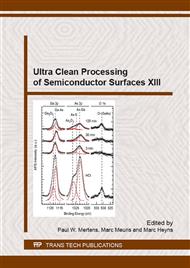p.227
p.232
p.237
p.242
p.245
p.251
p.255
p.260
p.265
High Throughput Wet Etch Solution for BEOL TiN Removal
Abstract:
Sub-10 nm technology node manufacturing processes may require the use of thicker and denser TiN hard mask for patterning at the BEOL. The modified TiN, which tends to be more chemically robust, must be removed using a wet etch process, while maintaining typical throughput - no extension of typical wet etch process times. To satisfy these needs, a new TiN etching accelerator was found that enhanced the activity of peroxide-related species in a wet etch chemical formulation that achieved increased TiN etch rate relative to formulation without TiN etch rate accelerator (Sample 1), while also minimizing the damage to ultra-low-k inter layer dielectric (ILD) layer by a strong base, also present in the formulation. We report here the result of a solvent based formulation, which adopted the TiN etching accelerator. The formulation was able to maintain TiN etch rate and remove post-etch residue, while remaining selective to ultra-low-k ILD, Co and Cu. The TiN etch rate of the accelerator enhanced formulation can be further tuned by modifying the process temperature or the hydrogen peroxide to formulation mixing ratio and has the potential capability to process > 400 wafers.
Info:
Periodical:
Pages:
245-250
Citation:
Online since:
September 2016
Authors:
Keywords:
Price:
Сopyright:
© 2016 Trans Tech Publications Ltd. All Rights Reserved
Share:
Citation:


